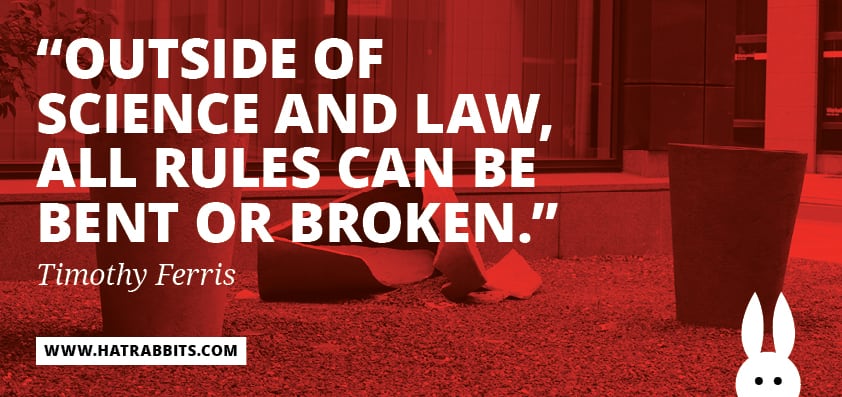The Creative Escape – challenge your assumptions and generate innovative ideas
We make assumptions all day long. This isn’t necessarily a bad thing. It allows us to make quick decisions and enables us to work efficiently. However, when it’s creative ideas you’re after, you’ll need to challenge the things that would otherwise seem beyond any doubt. Ask yourself “Is this really true?” even though something seems obvious.
Doing so, you’ll notice that while some assumptions are clearly right, others have become obsolete or where never true to begin with!
Shaking off the most ingrained assumptions isn’t easy. Luckily there is a simple thinking technique to help you break free: the Creative Escape.
The Creative Escape
The Creative Escape allows you to escape your assumptions. The technique is particularly useful for developing new products or services, yet can also be used in various other situations where creativity is required.
Using the technique, you target the assumptions that seem most evident. After all, breaking the ‘rules’ (especially those that seem unbreakable) is a recipe for innovation.

Here is how the technique works
Step 1. Write down five things that are absolutely CRUCIAL in your situation. What is necessary beyond doubt? What would only a fool discard?
Step 2. Look at your list and cross out what you consider to be the most essential element. What can’t possibly be left out?
Step 3. Allow yourself a short period of time to think (about 5 minutes is plenty of time) and generate as many ideas as possible for ways in which your product, service or situation works WITHOUT the ‘necessary’ component. What would you do if the crossed-out element wouldn’t be available? How would you make sure that your product or service would still be valuable?
Allow me to illustrate how this seemingly curious technique works:
Example: an unusual restaurant
Imagine, you want to open a new restaurant. Because competition is fierce, you are determined to come up with an entirely new restaurant-concept. Something no foodie in your town has ever seen before.
The Creative Escape is the perfect technique to help you succeed in reaching this ambitious goal.
Step 1. Write down 5 things that are essential for any restaurant to be successful
What does a restaurant need to be successful? If you would ask a random group of people, they would probably come up with a list that looks something like this:
- A kitchen
- Good customer service
- Employees
- A tasteful decor
Step 2. Cross out what is absolutely indispensable
In this case, you might cross out ‘a kitchen’. After all, how can a restaurant ever flourish without a kitchen?
Step 3. Generate as many ideas as possible WITHOUT the eliminated element
This might seem like an impossible exercise. Yet, if you’ll try it, you’ll notice how almost anything can be replaced and virtually any ‘irreplaceable’ element can easily be removed.
Don’t believe me? Let’s once more look at the list above.
1. A kitchen
Can any restaurant be successful without a kitchen? Yes, it can.
Several years ago, brewing company Bavaria and food-delivery company Thuisbezorgd opened a pop-up restaurant without a kitchen, but with an extensive menu. Oddly, on the menu were both Japanese, Turkish, Italian and Thai dishes. When a customer would order one of the many dishes on the menu, the staff would send a courier to a nearby restaurant to pick up the order. When the delivery guy returned with his package, one of the waiters would quickly serve the food to the customer’s table …accompanied with a cold Bavaria beer of course.
2. Good customer service
In this time of social media and online reviews, good customer service seems vital to any restaurant owner with aspirations. However, it turns out that utter rudeness can be a unique selling point too…
Hotdog joint The Wieners Circle is famous for its offensive staff. Ever since the staff started insulting customers, The Wieners Circle became a hit! People now visit the curious establishment in Chicago to witness the extremely hostile employees and this hasn’t been bad for business at all… From the moment politeness went out the door, turnover doubled!
3. Employees
Sure, a restaurant with verbally abusive staff can be successful, but what if you eliminate staff altogether? Well, that’s exactly what Dutch chef Dennis de Haan did in his restaurant. Guests pour their own drinks and keep a tab of what they took from the bar. All but the preparation of the dishes is in the customers’ own hands. A glance at the calendar with availability shows you just how good business is for De Haan.
4. A tasteful decor
By now, it won’t surprise you that a tasteful decor is not nearly as important as you would initially suspect. Restaurant C-Taste, for instance, is pitch black. The entire dining room is blinded and guests can see absolutely nothing. Staff is blind and a blind waiter will guide you to your table. By the time you finally hit something edible, after vigorously poking your fork in the direction your plate is supposed to be, you’re in for a unique experience. As you don’t see what you put in your mouth (and they won’t tell you until after you’re finished) you can no longer rely on your eyes to inform you on what to expect.
In Taiwan, a restaurant chain took eliminating tastefulness one step further. The Marton restaurant has an undeniably original theme:
What do you consider to be obvious in your situation? What is (seemingly) essential? And what will happen if you dare to challenge that assumption?





